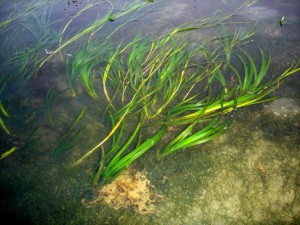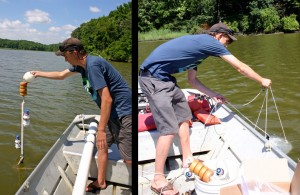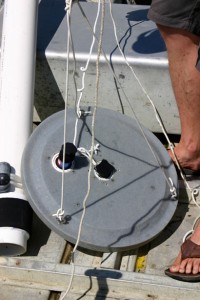
Around the world seagrasses are being lost. Turbidity is one factor that impedes their growth. However, in some places water quality has improved, but the grasses have not rebounded. SERC scientists wonder if a 'carpet of fluff'—a mix of organic and inorganic particles that floats just above the sediment—is blocking the sunlight seedlings need to grow. Photo: Tim Carruthers courtesy of IAN/UMCES.
Around the world, submerged seagrasses are being lost, primarily due to human activities. Scientists and resource managers are anxious to reverse the trend because the plants play a vital role in coastal ecosystems. They provide food, habitat and help filter the water. Gallegos and Pedersen think the murky fluff could impede seagrass restoration efforts. Pedersen came to SERC to quantify and potentially model the amount of sunlight that is able to penetrate the fluff, a measurement known as “light attenuation.”
Denmark’s Roskilde Fjord is where Pedersen has done most of his research. The narrow, 24-mile passage eventually connects to the North Sea. Pedersen says its shallow waters once protected Vikings from invaders. Today’s inhabitants are more concerned with eelgrass than attacks from foreign ships. According to Pedersen, Denmark has worked hard to improve water quality over the past couple decades by adopting stricter regulations on urban and agricultural runoff. While measurements of the water column show that it is cleaner, the eelgrass has not rebounded as expected.

On one side of the boat Pedersen lowers a traditional light sensor into the water (left). This one dangles from a buoy and measures sunlight higher up in the water column. On the other side (right), he places the new sensor that will sink into the sediment and measure the light that reaches the creek's floor.
Pedersen crossed the Atlantic to seek out Gallegos. Gallegos is an expert on hydrologic optics, the physics of how light behaves in water. The two are most interested in the spectrum of light that plants use for photosynthesis. Traditionally, scientists measure light attenuation higher up in the water column, above the layer of fluff. They then use mathematical equations to estimate the percent of sunlight that reaches the water’s floor. Eelgrass, for example, grows best when around 20 percent of the sunlight that hits the water’s surface, penetrates to the sediment. Gallegos and Pedersen are testing the accuracy of relying solely on the water column measurement to determine light attenuation at the sediment.

A close-up of the new sediment-level light sensor. Pedersen hopes this will tell him how much sunlight the 'carpet of fluff' is blocking.
On a sunny Friday morning in June, Pedersen hops in a boat and motors to Muddy Creek, a subestuary of the Chesapeake Bay. He carries with him three main instruments: a sediment trap and two light sensors. One sensor dangles from a buoy and floats in the water column, the other sinks to the bottom of the creek, below the carpet of fluff. For the next few hours these will record light readings at ten-minute intervals. After Pedersen retrieves the instruments, he will compare the traditional way of measuring light attenuation within the water column, with the readings that the new sediment-level sensor has given him.
When Pedersen wades into the water to collect the sediment trap and sensors, he sinks knee-deep in mud. This is why he chose the creek. Pedersen is testing the light sensors along a gradient of sediments: from muddy to sandy. Back in the lab, he will analyze his sediment samples to find out exactly how much organic material is in them. He is trying to determine if there is a correlation between the fluffy layer’s organic content and the light attenuation. Combined with the light readings, this information may help explain the lag-time between water quality improvements and the reappearance of seagrass. It may also yield new insight that will guide resource managers on where to focus their underwater vegetation restoration efforts.
Pedersen says he needs to gather many more measurements before he knows whether or not he and Gallegos have discovered a new way to measure a murky problem. He will continue his research at SERC until October.


Great research on grasses. I hope it can lead to an answer on why all the frogs are dying off.
Bob